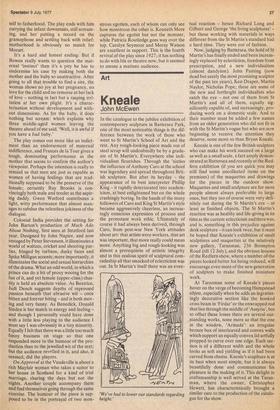Art
Kneale
John McEwen
In the catalogue to the jubilee exhibition of contemporary sculpture in Battersea Park, one of the most noticeable things is the difference between the work of those who went to St Martin's School of Art and the rest. Any rough-looking piece made out of steel scrap will undoubtedly be by a gradu-, ate of St Martin's. Everywhere else individualism flourishes. Through the 'sixties the influence of Anthony Caro at the school was legendary and spread throughout British sculpture. But after its heyday — the appearance of its best interpreter Phillip King — it rapidly deteriorated into academicism, at best enlightened but on the whole crashingly boring. In the hands of the many followers of Caro and King St Martin's style became aggressively cheerless, an increasingly conscious expression of process and the protestant work ethic. Ultimately of course it had always been derived, through Caro, from post-war New York attitudes about art: that artists were workers, that art was important, that more really could mean more. Anything big and rough-looking was almost a prerequisite of artistic integrity and in this zealous spirit of sculptural comradeship all that smacked of eclecticism was out. In St Martin's itself there was an even tual reaction — hence Richard Long and Gilbert and George 'the living sculptures' — but those working with materials in ways different from the St Martin's standard had a hard time. They were out of fashion.
Now, judging by Battersea, the hold of St Martin's has finally ended and been increasingly replaced by eclecticism, freedom from prescription, and a new individualism (almost dandyism). John Panting (now dead but surely the most promising sculptor of the past ten years), Ken Draper, Martin Naylor, Nicholas Pope; these are some of the new and forthright individualists who catch the eye — not one of them from St Martin's and all of them, equally significantly capable of, and increasingly, producing work on a domestic scale. And to their number must be added a few names from an older generation who did not fit in with the St Martin's vogue but who are now beginning to receive the attention they deserve, none more so than Bryan Kneale.
Kneale is one of the few British sculptors who can make his work succeed on a large as well as a small scale, a fact amply demonstrated at Battersea and recently at the Redfern exhibition (if you are quick you may still find some uncollected items on the premises) of the maquettes and drawings for the pieces in the outdoor show. Maquettes and small sculpture are for most people almost always preferable to large ones, but they too of course were very definitely out during the St Martin's. era — at least as finished objects. The St Martin's reaction was as healthy and life-giving in its time as the current eclecticism a nd there was, and is, something in this prejudice against desk sculpture it can look twee, but it must be hoped that Kneale's exhibition of small sculptures and maquettes at the relatively new gallery, Taranman, 236 Brompton Road (till 12 July), and the obvious lessons of the Redfern show, where a number of the pieces looked better for being reduced, will encourage even more of the new generation of sculptors to make finished miniature work.
At Taranman some of Kneale's pieces hover on the verge of becoming Hampstead objets, especially when he adds an ingratiatingly decorative section like the hooked cross beam in 'Firdar' or the enwrapped rod that lies through the middle of 'Assyria', but to offset these losses there are several out.standing works, none more so that the one in the window, 'Armada': an irregular bronze box of interleaved and convex walls which support an equally 'convex lid artfully propped to curve over one edge. Each section is of a different width and the whole looks as soft and yielding as if it had been carved from cheese, Kneale's scuplture is at its best when most simple, but it is always beautifully done and communicates his pleasure in the making of it. This delight in craftsmanship is well served at the Taranman, where the owner, Christopher Hewett, has characteristically brought a similar care to the production of the catalogue for the show.


































 Previous page
Previous page